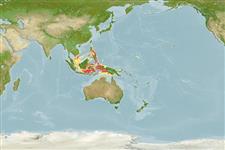Common names from other countries
>
Eupercaria/misc (Various families in series Eupercaria) >
Latilidae (Deepwater tilefishes)
Etymology: Branchiostegus: Greek, brangchia = gills + Greek, stego = roof, to cover (Ref. 45335).
More on author: Herre.
Issue
Validity of this species remains unconfirmed (Ref. 8991). Considered as nomen dubium by Dooley and Iwatsuki (2012:31, Ref. 89848).
Environment: milieu / climate zone / depth range / distribution range
Ecología
marino demersal. Tropical
Distribución
Países | Áreas FAO | Ecosistemas | Ocurrencias, apariciones | Point map | Introducciones | Faunafri
Western Pacific: Manila, Philippines.
Tamaño / Peso / Age
Maturity: Lm ? range ? - ? cm
Max length : 24.0 cm SL macho / no sexado; (Ref. 9920)
Life cycle and mating behavior
Maturities | Reproducción | Spawnings | Egg(s) | Fecundities | Larva
Herre, A.W.C.T., 1926. Four new Philippine fishes. Philipp. J. Sci. 31(4):533-543. (Ref. 9920)
IUCN Red List Status (Ref. 130435)
CITES (Ref. 128078)
Not Evaluated
Threat to humans
Harmless
Human uses
Herramientas
Special reports
Download XML
Fuentes de Internet
Estimates based on models
Phylogenetic diversity index (Ref.
82804): PD
50 = 0.5000 [Uniqueness, from 0.5 = low to 2.0 = high].
Bayesian length-weight: a=0.00832 (0.00400 - 0.01728), b=3.11 (2.92 - 3.30), in cm Total Length, based on LWR estimates for this (Sub)family-body shape (Ref.
93245).
Nivel trófico (Ref.
69278): 3.5 ±0.5 se; based on size and trophs of closest relatives
Resiliencia (Ref.
120179): Medio, población duplicada en un tiempo mínimo de 1.4-4.4 años (Preliminary K or Fecundity.).
Fishing Vulnerability (Ref.
59153): Low vulnerability (19 of 100).
